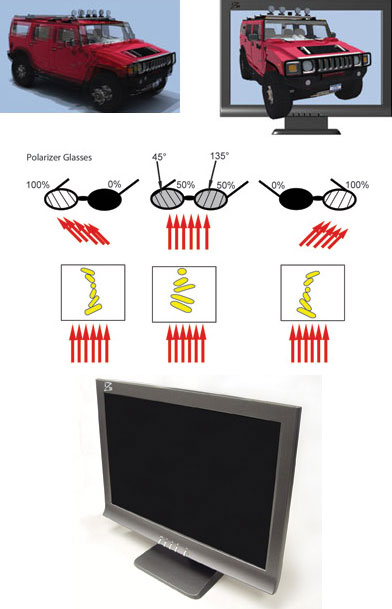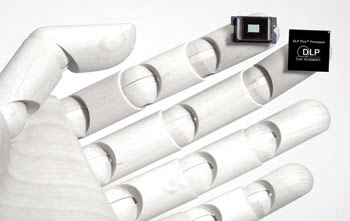Hank Hogan, Contributing Editor, hank@hankhogan.com
The Duchess of Windsor was half right, at least as far as displays are concerned: They really never can be too thin, as evidenced by the rise of flat screens of all varieties and of displays that can be virtually anywhere. But as for being too rich, she was partially wrong. On the one hand, displays can definitely be too expensive, in either initial cost or ongoing energy consumption. However, they can never do too much, as shown by screens that accept input via multifinger touch.
Recent advances promise to help displays on all of these fronts. Some of the applications that will result from these technological innovations will be fairly standard, noted Paul Drzaic. He’s president of the Society for Information Display, the professional organization for those in display research, design, manufacturing, applications and marketing.
But some of the new uses enabled by the novel display technologies are anything but the norm, Drzaic said. “There are new application areas, brand-new things people haven’t seen before. 3-D displays would fall into that category.”
A look reveals recent advances in display technology, as well as ongoing trends. Together they show what may be coming soon to a screen near you.
Soon in three dimensions
One of the biggest emerging trends involves something that promises to bring displays into the real world. Despite what can be seen on screens, the world isn’t flat. Although attempts that date back decades have been made to correct this, the third dimension has been missing. Displays today present videos, still pictures and everything else in 2-D.
That is about to change. Advances in technology have made viewing and generation of 3-D content easier and less expensive than ever. That, in turn, is expected to drive the deployment of 3-D movies, games, photos and television. The arrival sequence is expected to be in roughly that order because of two intertwined requirements, according to Jennifer Colegrove, director of display technologies at DisplaySearch. The Austin, Texas-based firm tracks flat panel display markets and technologies.

Polarizing glasses and liquid crystal are pushing 3-D technologies. Dynamic polarization management presents different images to the right and left eyes, producing one with depth [top right image]. This is done using a modified flat panel [below] display and could soon be the norm for gaming systems and eventually for TV. Courtesy of iZ3D.
As she explained when talking about the last category, “3-D TV relies on several factors. One, is the display technology available? Another, is there 3-D content on the TV or DVD?”
On the content side, she noted that 3-D movies already exist, with perhaps a dozen in the pipeline and expected to premiere over the next 12 to 18 months. Television broadcasts in 3-D, however, are so rare as to be almost nonexistent in the US, although there was a 3-D movie trailer shown during this year’s Super Bowl.
On the technology side, 3-D displays have to present two slightly different 2-D images, one for the right eye and another for the left. The two are then interpreted by the brain as a single 3-D image.
These distinct and separate images can be displayed in a number of ways, but the most common for larger, shared screens is through the use of glasses. In one implementation, the display polarizes the images, and polarized material in the glasses ensures that the proper image gets to the correct eye. In another, the glasses are used as shutters, synchronized with the changing images on the display so that each eye sees only the appropriate image.
The first approach is more demanding of the display but easier on the glasses, which are passive devices and can therefore be light and inexpensive. The second is easier on the display, although it does require that it be fast enough to switch quickly between images. The active glasses, however, are more complex and tend to be heavier and more expensive than passive ones.
The 3-D market is at present very small, but Colegrove thinks the technology is ready.
Fun and games
Games are expected to go 3-D before television does for a number of reasons. One is that hard-core gamers are willing to spend money, and they tend to be early adopters of technology, characteristics that make them a potential market. Another is the result of a decision made years ago by game developers in response to another attempt to deliver 3-D game content.
“Most of the games have 3-D information embedded in their 2-D versions,” said Thomas Striegler, president and CEO of iZ3D. The San Diego-based start-up company offers a 3-D monitor for gamers. Introduced last year, it uses the inherent characteristic of liquid crystals to dynamically change the polarization on a pixel-by-pixel basis. Combined with linearly polarized viewing glasses, this allows left and right image information to end up in the correct eye.
The monitor is about 50 percent more expensive than a similarly sized 2-D one, largely because it has a second LCD layer that controls the polarization and thereby produces images with depth. The 3-D monitor also has to have a brighter backlight than a 2-D one because of the two LCD layers that must be transited instead of the one found in a 2-D monitor.
Striegler said that a polarization approach, which uses passive glasses and not ones with a shutter in them, offers the advantage of minimizing visual and mental strain on the viewer. Polarization-based techniques are used in 3-D movies, although circular polarization is the focus, not the linear polarization used by iZ3D.
The company plans to go both big and small with its monitors. The larger ones will be for high-definition home entertainment, either broadcast or recorded. The smaller ones will show up in phones and other handheld devices. In that case, the implementation may be different because there are other technologies than LCDs that could be used.
Going deep on small screens
For example, Qualcomm MEMS Technologies of San Diego has a reflective display technology that works by using electrostatics to change an air gap in a minuscule subpixel microelectromechanical systems (MEMS) element, thereby turning the element on or off. Different air gaps lead to different colors when the element is on.
Because the company is a subsidiary of cell phone chip maker Qualcomm, it’s no surprise that its products show up in handsets, in part because they consume very little power when displaying unchanging pixels.
Texas Instruments of Dallas has a micromirror-based digital light processor (DLP) chip set small enough to be embedded in a cell phone. The chip works by reflecting light from a source, such as an LED. Frank Moizio, DLP emerging markets business manager, noted that the technology allows for a 20-in. projected image to be visible in ambient light.

Displays will be seen everywhere, thanks to recent technical advances. A micromirror chip set, like the one shown right, embedded in a cell phone could allow virtually any flat surface to be a display, even a 3-D one. Courtesy of Texas Instruments.
Doing so would allow the display on a cell phone to be shared anywhere there’s a suitable surface, such as a wall, with the inherent switching speed enabling high contrast, a wide color range, sharp images and more, Moizio said. “In addition, it allows for advanced features like 3-D imaging using stereoscopic techniques.”
For those who don’t care about sharing images, a third 3-D variation involves miniature displays mounted in the glasses themselves. These small displays act as virtual larger ones, thus providing the visual cues needed for 3-D imagery. There are also ways to achieve 3-D effects without glasses, but today most flat panels that do this are limited in size for cost reasons. These autostereoscopic approaches also don’t work as well, at present, as other methods when fast-moving images are involved.
The right touch
While 3-D may be attracting attention, another strong theme is screens that do more than just display information, they also act as input devices through the use of touch or other means. Methuen, Mass.-based 3M Touch Systems, a 3M subsidiary, recently released a 10-finger multitouch developer kit that Kelly Devin, marketing manager for the company, said is based on projected capacitive technology. She noted that the company’s multitouch capability does not demand a high-end computer.

Displays will become ubiquitous input devices, like the one shown here with a 10-finger touch screen. Courtesy of 3M.
“We use standard business PCs, nothing fantastic,” she said. “To track all 10 fingers at one time gives you roughly a 15-ms response time. So we’re processing the inputs quite quickly.”
As for where multitouch displays might show up, classrooms are a possibility, as are conference rooms, where collaboration is needed, and home entertainment systems. Smaller screens, such as those found on cell phones, will be limited in the number of touch inputs that can be effectively used because of finger size.
According to figures from DisplaySearch, the market for multitouch displays is expected to grow quickly. The total touch-screen module market stood at an estimated $3.6 billion in 2008, with multitouch accounting for about 25 percent of that. By 2015, the total touch-screen module market is forecast to be $9 billion. Of that, $4.2 billion will be multitouch.
There are applications, such as the kiosks used for airline check-in or specialized registers in restaurants, where single-touch is fine. Those settings are unlikely to switch to more expensive multitouch technology.
Boosting brightness while cutting power
Finally, there are enhancements that promise to bring high-brightness yet thin and low-power displays to televisions and mobile devices. Some of these can be found in the backlight that sits behind every LCD. Switching to LEDs can cut power by as much as 30 percent and can result in sharper images, both courtesy of the ability to rapidly modulate the output from an LED.
That same ability could prove useful in other areas, as there have been demonstrations where a modulated backlight has been used as a communication channel. One possibility would be to have the display communicate with a cell phone or computer pointed at it, like a TV remote in reverse.
Other improvements involve the liquid crystals themselves. The next generation of displays could employ the polymer-stabilized vertical alignment material developed by Merck KGaA of Darmstadt, Germany. Thanks to an additional polymer layer, the molecules in the display material are pre-aligned in a particular direction. As a result, contrast is improved, switching times are faster, and transmission of the light through the medium is increased.
The last, in turn, means that the backlight brightness can be significantly reduced. Since the backlight is the major energy sink in an LCD, the material cuts the power consumed by such things as TVs and extends battery life in mobile devices. Roman Maisch, senior vice president of marketing and sales in Merck’s liquid crystals division, noted that the new material is already being put to use in LCD TVs.
In summing up the material demands of tomorrow’s displays, he also outlined where the overall display market is heading, noting, “Faster switching times will be also for the future a key driver for the development of liquid crystal materials. Another factor which drives the development of liquid crystal materials is the trend for green products.”
For information on projection technology, see “Pico Boom” on page 76.